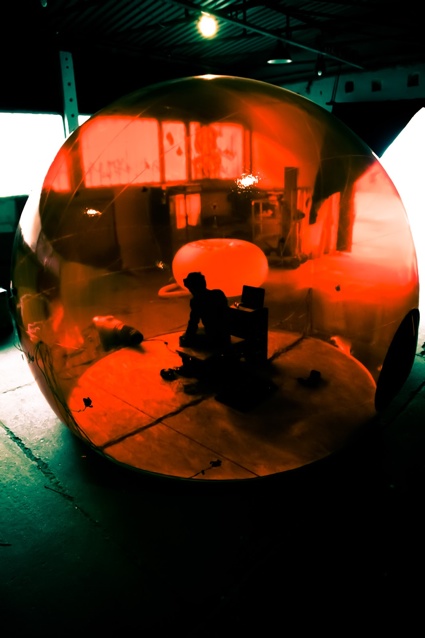On Wednesday, the Saatchi Gallery will open Red Never Follows. The exhibition features 20 contemporary artists and celebrates the 20th anniversary of HUGO. In fashion speak, the show has been called a ‘pop-up exhibition’.
Judging from the programme, Red Never Follows should make for a very entertaining Summer distraction (whether you’re interested in fashion and aftershave or not): inflatable architecture, virtual painting using visitors body movements, pulsating kinetic sculpture, floor to ceiling ultra violet-light installation, robot and a bit of street art thrown in for good measure.
 Marco Barotti & Plastique Fantastique
Marco Barotti & Plastique Fantastique
Red Never Follows is open 31 July – 1 September at the Saatchi Gallery in London.
The image i’ve used on the homepage is US (Christopher Barrett & Luke Taylor), Benga – I Will Never Change.
I was commissioned an editorial for the exhibition website and I was in jolly company. Filip Visnjic from Creative Applications wrote about Breeding Innovation, Julia Kagansky from the Creators Project was assigned Creativity and Lifestyle, Peter Kirn from Create Digital Music wrote about the discipline blur, Verena Dauerer from Design Journalists produced a text about global trends & innovation. That said, i didn’t win the lottery with the theme i was given: Brands as creative enablers. But i do like a challenge, the result of which i was asked to copy/paste here:
From alcoholic genius Orson Welles celebrating the virtues of Paul Masson chablis on TV commercials to rapper Nicki Minaj designing a line of lipsticks for MAC Cosmetics, the idea that brands are champions of creativity can be taken in its most literal guise. It’s a case of elementary mathematics, of iconic figures adding their aesthetics and/or charisma to the surface of a brand. When the temporary alliance is successful, both parties are happy, the product acquires edge and visibility, profiles are raised, everyone takes their share of the profit.
Over the years, however, several collaborations have demonstrated that the brand/creator coalition can enter into a more mutually fruitful dialogue. And in these instances, the mathematical operation generates a result far greater than the sum of its parts.
Various scenarios can emerge at different stages of a creative career. Brands can intervene early, at educational levels, partnering up for example with interaction design departments to investigate the future of money, mobility or health care. The goal is not to come up with the next killer app or gadget but to help both the brand and the student sharpen their discourse, focus and outlook at upcoming potential areas of investigation. At the other end of the spectrum are brands that team up with a creator, or group of creators who have already gained recognition (albeit sometimes a fairly marginal one.) The company will commission them to devise a new intervention, a performance or an artefact. Creators might then have free rein, either exploring further a direction they were already working on or taking the commission as a challenge and opportunity to experiment with even bolder ideas. The results can definitely be arresting. The most absurdly endearing example I’ve ever seen dates back to 2007 when a British style magazine asked Miltos Manetas to come up with a website that expressed the huge debt felt by artists towards Andy Warhol. The outcome is a seemingly never-ending animation of cute creatures literally saying a million thank you’s to the pop art guru. More recently, Yuri Suzuki drove around London in a taxi equipped with a microphone that recorded ambient noise such as traffic, police sirens, pneumatic drills, etc. while specially designed software analyzed the frequencies of the rather unpleasant urban sound, and used them to compose and play music in real time. All in the name of a new headphone release that would not have generated such a buzz among design and music aficionados.
As the examples above demonstrate, the dialogue between the commissioning company and the creative individual(s) doesn’t necessarily involve any direct commercial application. Sometimes, it is not even about long-term brand building. Instead, we are talking about two partners reveling in the freedom to experiment, take risks and surprise.
I won’t conclude that one model of collaboration should be abolished at the benefit of the other. I am perfectly happy with the idea that both types of alliances coexist. The one that involves little more than Shepard Fairey slapping his OBEY Giant character onto a pack of Trusto Cereal. And the partnership that requires both parties to challenge themselves, throw their own boundaries through the window and look for new forms of expression. Whether we’re talking about graphic design at breakfast or remastered urban cacophony, all directions deserve to be explored. If anything for a practical reason: long gone are the days when the artist had to be this romantic figure who starved in the name of pure beauty. Nowadays, creators need to pay their rent too and as long as they don’t feel like they are losing their soul and credibility in the deal, they can use the collaboration as a platform to gain wide exposure and opportunities for professional and artistic development.
But the other reason is that most people don’t feel the need nor desire to enter art galleries, theater halls and museums and that is fair enough. Art, design, music and other creative disciplines are never as powerful as when they exit the air-conditioned safety of institutional and commercial white cubes and go directly to the public. That’s precisely where brands have an opportunity to step in and play a more nurturing role to young creativity. Because, for better or for worse, brands are everywhere we look, walk, eat and socialize.
I’ve never met anyone who said that our cities and sheer human existence were in dire need of more branding. We could, however, all do with a little more creativity and imagination in our life.
